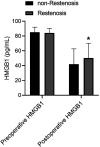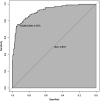The clinical significance of serum HMGB1 in patients with lower extremity arteriosclerosis obliterans after interventional vascular restenosis
- PMID: 36704514
- PMCID: PMC9872960
- DOI: 10.3389/fsurg.2022.1031108
The clinical significance of serum HMGB1 in patients with lower extremity arteriosclerosis obliterans after interventional vascular restenosis
Abstract
Objective: This study explored the correlation between serum HMGB1 levels and postoperative vascular restenosis in patients with lower extremity arteriosclerosis obliterans (LEASO).
Methods: A total of 362 patients LEASO who received vascular intervention were recruited in this study. Serum HMGB1 levels were measured by enzyme-linked immunosorbent assay. Logistic regression analysis was used to identify the influencing factors associated with vascular restenosis. The R procedure was used to create nomogram model. Receiver operating characteristic (ROC) analysis was used to determine the predictive value of serum HMGB1 and nomogram model for vascular restenosis.
Results: Of the 362 LEASO patients included, 103 (28.45%) developed restenosis within 6 months of postoperative follow-up. Postoperative HMGB1 levels were significantly higher in patients with restenosis compared to those with non-restenosis. Postoperative HMGB1 levels were significantly and positively correlated with the severity of postoperative restenosis (r = 0.819). The AUC of postoperative HMGB1 for the diagnosis of postoperative restenosis was 0.758 (95% CI: 0.703-0.812), with a sensitivity and specificity of 56.31% and 82.24%, respectively. Multivariate logistic regression analysis showed that diabetes, smoking, regular postoperative medication, increased fibrinogen, decreased red blood cells, increased hs-CRP, and increased postoperative HMGB1 were independently associated with postoperative restenosis in patients with LEASO. The C-index of the nomogram prediction model constructed based on the seven influencing factors mentioned above was 0.918. The nomogram model was significantly more predictive of postoperative restenosis in LEASO patients compared with a single postoperative HMGB1 (AUC: 0.918, 95% CI: 0.757-0.934).
Conclusion: Postoperative serum HMGB1 is an independent risk factor associated with postoperative vascular restenosis in patients with LEASO, and a novel nomogram model based on postoperative serum HMGB1 combined with clinical characteristics may help to accurately predict the risk of postoperative restenosis in patients with LEASO.
Keywords: HMGB1; lower extremity arteriosclerosis obliterans; nomogram model; vascular interventional therapy; vascular restenosis.
© 2023 Yang and XiaPing.
Conflict of interest statement
The authors declare that the research was conducted in the absence of any commercial or financial relationships that could be construed as a potential conflict of interest.
Figures





References
-
- Conte MS, Pomposelli FB, Clair DG, Geraghty PJ, McKinsey JF, Mills JL, et al. Society for vascular surgery practice guidelines for atherosclerotic occlusive disease of the lower extremities: management of asymptomatic disease and claudication. J Vasc Surg. (2015) 61:2s–41s. 10.1016/j.jvs.2014.12.009 - DOI - PubMed
-
- Liistro F, Porto I, Angioli P, Grotti S, Ricci L, Ducci K, et al. Drug-eluting balloon in peripheral intervention for below the knee angioplasty evaluation (DEBATE-BTK): a randomized trial in diabetic patients with critical limb ischemia. Circulation. (2013) 128:615–21. 10.1161/CIRCULATIONAHA.113.001811 - DOI - PubMed
LinkOut - more resources
Full Text Sources
Research Materials
Miscellaneous

